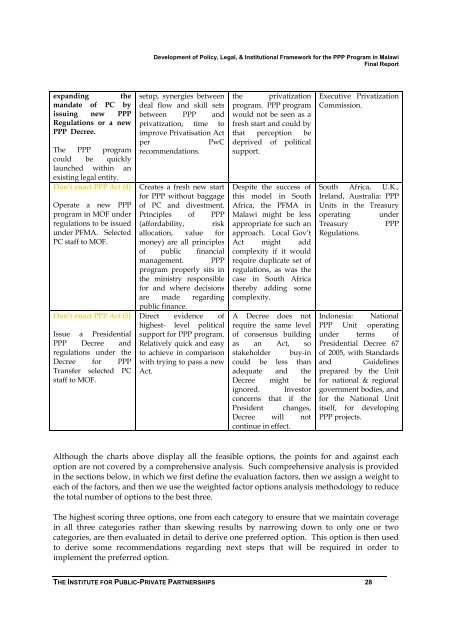Development of Policy, Legal, and Insitutional Framework for - ppiaf
Development of Policy, Legal, and Insitutional Framework for - ppiaf
Development of Policy, Legal, and Insitutional Framework for - ppiaf
Create successful ePaper yourself
Turn your PDF publications into a flip-book with our unique Google optimized e-Paper software.
<strong>Development</strong> <strong>of</strong> <strong>Policy</strong>, <strong>Legal</strong>, & Institutional <strong>Framework</strong> <strong>for</strong> the PPP Program in Malawi<br />
Final Report<br />
exp<strong>and</strong>ing the<br />
m<strong>and</strong>ate <strong>of</strong> PC by<br />
issuing new PPP<br />
Regulations or a new<br />
PPP Decree.<br />
The PPP program<br />
could be quickly<br />
launched within an<br />
existing legal entity.<br />
Don’t enact PPP Act (4)<br />
Operate a new PPP<br />
program in MOF under<br />
regulations to be issued<br />
under PFMA. Selected<br />
PC staff to MOF.<br />
Don’t enact PPP Act (5)<br />
Issue a Presidential<br />
PPP Decree <strong>and</strong><br />
regulations under the<br />
Decree <strong>for</strong> PPP<br />
Transfer selected PC<br />
staff to MOF.<br />
setup, synergies between<br />
deal flow <strong>and</strong> skill sets<br />
between PPP <strong>and</strong><br />
privatization, time to<br />
improve Privatisation Act<br />
per<br />
PwC<br />
recommendations.<br />
Creates a fresh new start<br />
<strong>for</strong> PPP without baggage<br />
<strong>of</strong> PC <strong>and</strong> divestment.<br />
Principles <strong>of</strong> PPP<br />
(af<strong>for</strong>dability, risk<br />
allocation, value <strong>for</strong><br />
money) are all principles<br />
<strong>of</strong> public financial<br />
management. PPP<br />
program properly sits in<br />
the ministry responsible<br />
<strong>for</strong> <strong>and</strong> where decisions<br />
are made regarding<br />
public finance.<br />
Direct evidence <strong>of</strong><br />
highest- level political<br />
support <strong>for</strong> PPP program.<br />
Relatively quick <strong>and</strong> easy<br />
to achieve in comparison<br />
with trying to pass a new<br />
Act.<br />
the privatization<br />
program. PPP program<br />
would not be seen as a<br />
fresh start <strong>and</strong> could by<br />
that perception be<br />
deprived <strong>of</strong> political<br />
support.<br />
Despite the success <strong>of</strong><br />
this model in South<br />
Africa, the PFMA in<br />
Malawi might be less<br />
appropriate <strong>for</strong> such an<br />
approach. Local Gov’t<br />
Act might add<br />
complexity if it would<br />
require duplicate set <strong>of</strong><br />
regulations, as was the<br />
case in South Africa<br />
thereby adding some<br />
complexity.<br />
A Decree does not<br />
require the same level<br />
<strong>of</strong> consensus building<br />
as an Act, so<br />
stakeholder buy-in<br />
could be less than<br />
adequate <strong>and</strong> the<br />
Decree might be<br />
ignored. Investor<br />
concerns that if the<br />
President changes,<br />
Decree will not<br />
continue in effect.<br />
Executive Privatization<br />
Commission.<br />
South Africa, U.K.,<br />
Irel<strong>and</strong>, Australia: PPP<br />
Units in the Treasury<br />
operating under<br />
Treasury<br />
PPP<br />
Regulations.<br />
Indonesia: National<br />
PPP Unit operating<br />
under terms <strong>of</strong><br />
Presidential Decree 67<br />
<strong>of</strong> 2005, with St<strong>and</strong>ards<br />
<strong>and</strong> Guidelines<br />
prepared by the Unit<br />
<strong>for</strong> national & regional<br />
government bodies, <strong>and</strong><br />
<strong>for</strong> the National Unit<br />
itself, <strong>for</strong> developing<br />
PPP projects.<br />
Although the charts above display all the feasible options, the points <strong>for</strong> <strong>and</strong> against each<br />
option are not covered by a comprehensive analysis. Such comprehensive analysis is provided<br />
in the sections below, in which we first define the evaluation factors, then we assign a weight to<br />
each <strong>of</strong> the factors, <strong>and</strong> then we use the weighted factor options analysis methodology to reduce<br />
the total number <strong>of</strong> options to the best three.<br />
The highest scoring three options, one from each category to ensure that we maintain coverage<br />
in all three categories rather than skewing results by narrowing down to only one or two<br />
categories, are then evaluated in detail to derive one preferred option. This option is then used<br />
to derive some recommendations regarding next steps that will be required in order to<br />
implement the preferred option.<br />
THE INSTITUTE FOR PUBLIC-PRIVATE PARTNERSHIPS 28
















